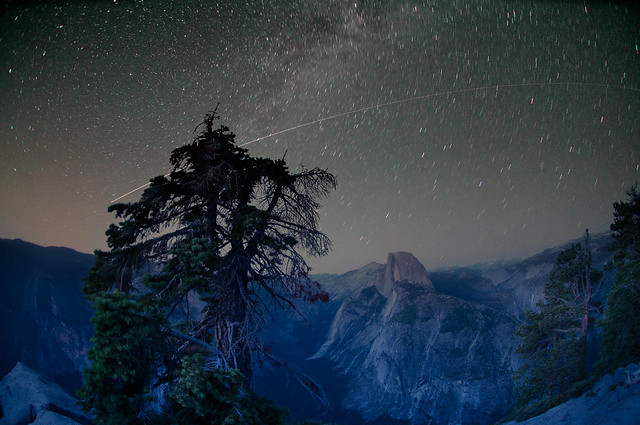
Leaving Berkeley in mid-afternoon, I grabbed a quick bite in Mariposa and made it up to Glacier Point just after sunset. There was still some light to see what I was doing. I took advantage of the last light to establish my tripod and make some shots I could use to layer in foreground detail.
The night was balmy, and a surprising number of people showed up on Glacier Point to watch the night sky like a movie. One family even brought popcorn. As it grew darker, I switched from manual exposure control to my programmable intervalometer (a fancy word for a timer).
By about midnight, the crowds had gone home and I was the last one left to witness the immensities of Yosemite Valley and the night sky. Besides the stars and Milky Way I saw satellites and a surprising number of planes on a flight path across Yosemite Valley. I also witnessed several dramatic shooting stars—including the one captured in the frame below.
Using my 10.5mm digital fisheye, to capture these star trails I made 39 exposures, with each exposure open for a shutter speed of four minutes at f/2.8 and ISO 320. My total exposure time was thusly about 2 hours and 40 minutes. I combined the exposures in Photoshop using the Statistics script and a smart-object layer stack with the method set to Maximum.
When I thought I’d captured enough, I crawled into my van in the parking lot, and grabbed a few hours sleep—ready to photograph at sunrise in a few hours.
Want to learn to make photos like this one? Consider joining Steven Christenson and myself in November at Star Circle Academy.

Steven Christenson
1 Aug 2011Hey Harold. I’d be curious to see what the streak looks like in a flattened (distortion corrected) image. The curvature – if it indeed is curved – would indicate an airplane. Such a long trail is also unusual for a meteor. Did you see this with your eyes as well? I saw a few from my vantage point in the south bay. If it’s really a meteor I’m jealous! If it’s not a meteor, I’m merely envious.
Harold Davis
1 Aug 2011@Steven: Be jealous! The curvature is due to the fisheye lens I used. A straight line photographed with this lens in that position would also curve.
Up close, it doesn’t have the repeating pattern you see in airplane trails (there also are some airplane trails in the other frames I could compare it to).
So I’d say flying saucer or meteor.
However, I and the other people on Glacier Point did see a very bright shooting star following the course shown (corrected for lens curvature of course :-))—so I’m pretty sure this is a meteor.
Pingback: The Forest and the Stars | Photoblog 2.0
Steven Christenson
5 Aug 2011Your meteor continues on in arc into the star trail (from above the tree limb into the horizon). Since it’s highly unlikely that some other thing (flying saucer?) followed that same trajectory I’m assuming it was made by the same moving light source.
Unfortunately that means its most likely a satellite or a high altitude plane (which renders the flashing wing and tail lights indistinguishable).
Using a site like http://www.heavens-above.com it’s possible to figure out which satellite this might have been.